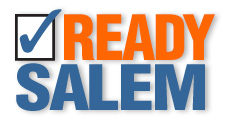Individual / Family
Home » Plan / Prepare »
Where will your family be when disaster strikes? They could be anywhere–at work, at school or in the car.
How will you find each other? Will you know if your children are safe?
Four Steps to Safety
1. Find Out What Could Happen to You:
Contact your local Emergency Management Office and the American Red Cross chapter nearest you and be prepared to take notes:
- Ask what types of disasters are most likely to happen.
Request information on how to prepare for each. - Learn about your community’s warning signals: what they sound like and what you should do when you hear them.
- Ask about animal care after disaster. Animals may not be allowed inside emergency shelters due to health regulations.
- Find out how to help elderly or disabled persons, if needed.
- Next, find out about the disaster plans at your workplace, your children’s school or daycare center and other places where your family spends time
2. Create a Disaster Plan
Meet with your family and discuss why you need to prepare for disaster. Explain the dangers of fire, severe weather and earthquakes to children. Plan to share responsibilities and work together as a team.
- Discuss the types of disasters that are most likely to happen. Explain what to do in each case.
- Pick two meeting places. One near your home in case of a fire. And, one outside your neighborhood in case you cannot return home after a disaster.
- Ask an out-of-state friend to be your “family contact.” After a disaster, its often easier to call long distance. Other family members should call this person and tell them where they are. Everyone must know your contact’s phone number.
- Discuss what to do in an evacuation. Plan how to take care of your pets.
3. Complete This Checklist
- Post emergency telephone numbers by phones (fire, police, ambulance, etc.).
- Teach children how and when to call 911 or your local Emergency Medical Services number for emergency help.
- Show each family member how and when to turn off the water, gas and electricity at the main switches.
- Check if you have adequate insurance coverage.
- Teach each family member how to use the fire extinguisher (ABC type), and show them where it’s kept.
- Install smoke detectors on each level of your home, especially near bedrooms.
- Conduct a home hazard hunt.
- Stock emergency supplies and assemble a Disaster Supplies Kit.
- Take a Red Cross first aid and CPR class.
- Determine the best escape routes from your home. Find two ways out of each room.
- Find the safe spots in your home for each type of disaster.
4. Practice and Maintain Your Plan
- Quiz your kids every six months so they remember what to do.
- Conduct fire and emergency evacuation drills.
- Replace stored food and water every six months
- Test and recharge your fire extinguisher(s) according to manufacturer’s instructions.
- Test your smoke detectors monthly and change the batteries at least once a year.
EMERGENCY SUPPLIES
Keep enough supplies in your home to meet your needs for at least three days. Assemble a Disaster Supplies Kit with items you may need in an evacuation. Store these supplies in sturdy, easy-to-carry containers such as backpacks, duffel bags or covered trash containers.
Include:
- A three-day supply of water (one gallon per person per day) and food that won’t spoil.
- One change of clothing and footwear per person, and one blanket or sleeping bag per person.
- A first aid kit that includes your family’s prescription medications.
- Emergency tools including a battery powered radio, flashlight and plenty of extra batteries.
- An extra set of car keys and a credit card, cash or traveler’s checks.
- Sanitation supplies.
- Special items for infant, elderly or disabled family members.
- An extra pair of glasses.
- Keep important family documents in a waterproof container. Keep a smaller kit in the trunk of your car.
- Remember that if you anticipate staying in an evacuation shelter that there may not be a cot for you. Bring bedding material and something to sleep on.
UTILITIES
Locate the main electric fuse box, water service main and natural gas main. Learn how and when to turn these utilities off. Teach all responsible family members. Keep necessary tools near gas and water shut-off valves.
Remember, turn off the utilities only if you suspect the lines are damaged or if you are instructed to do so. If you turn the gas off, you will need a professional to turn it back on.
NEIGHBORS HELPING NEIGHBORS
Working with neighbors can save lives and property. Meet with your neighbors to plan how the neighborhood could work together after a disaster until help arrives. If you’re a member of a neighborhood organization, such as a home association or crime watch group, introduce disaster preparedness as a new activity. Know your neighbors’ special skills (e.g., medical, technical) and consider how you could help neighbors who have special needs, such as disabled and elderly persons. Make plans for child care in case parents can’t get home.
HOME HAZARD HUNT
During a disaster, ordinary objects in your home can cause injury or damage. Anything that can move, fall, break or cause a fire is a home hazard. For example, a hot water heater or a bookshelf can fall. Inspect your home at least once a year and fix potential hazards.
Contact your local fire department to learn about home fire hazards.
ADDITIONAL RESOURCES
Please visit the Web Links provided on this page for additional information. You may also request free family protection publications by visiting www.Ready.gov or writing to:
FEMA Distribution Center
PO Box 430
Buckeystown, MD 21717
Telephone: (800) 480-2520
Fax: (240) 699-0525
